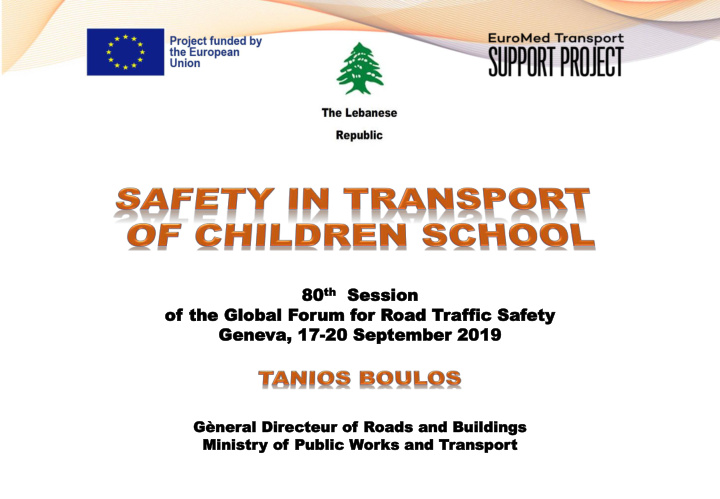



80 80 th Session Session of the G the Global F lobal For orum um for or Road oad Traf affic S fic Saf afety ety Gen Geneva, 17 va, 17-20 S 20 Septemb eptember er 201 2019 9 Gène Gè neral al Dir irec ecteu teur of of R Roa oads ds an and d Buildings uildings Minis Ministr try y of of P Publi ublic c Wor orks ks and and Transpor ansport
Reality, Obstacles, , Challenges in in Lebanon In Lebanon, the number of students divided among public, private, subsidized and refugee schools is 1,077,000 pupils. According to the assessment made by the secretariat of the National Road Safety Council, the obstacles to safe transport of children to schools and road safety are as follows: ❑ No organized public transport. ❑ There are national standards and standards for student transportation. ❑ Transport is varied . ❑ The specifications of the school buses ❑ Private schools have their own fleet of require each bus an adult to accampagner vehicles. students and a driver . ❑ Public schools do not have this facility . ❑ A lack of road safety experience and ❑ Walking and private car transport is culture among drivers . transportation for most other students in Lebanon.
Reality, Obstacles, , Challenges in in Lebanon The challenges are enormous: A lack of security around schools ❑ Lack of fund s to generalize the public Especially for public schools: transportation of students. (Public schools) ❑ Signs ❑ Failure to gua r antee vehicles meeting the ❑ Traffic calming measure standards required for the transportation of students. (Private schools) ❑ Passages for pedestrians ❑ The weak enforcement of the law ❑ Sidewalks regarding the standards of student transport vehicles and likewise for the maximum ❑ Areas of care number of students allowed to carry The National Road Safety Council has The organization of a second post in the launched a program to improve transport. afternoon for the education of Syrian refugee children has become an additional Some NGOs participate in the road safety challenge for their security. sensation for schoolchildren .
Speed li limits in in school zones School zones are installed to reduce traffic speed near schools during the times indicated in the school zone sign. School zones are identified by signs which are displayed on both approaches to the school and show the speed limit and the times during which it applies. School zones are generally permitted on roads adjacent to schools where there is significant school related activity on and beside the road.
Provide adequate facilities for r chil ildren to use ❑ Refuge / traffic island, median ❑ Kerb extension ❑ Pedestrian traffic signals ❑ Road narrowing, indented parking ❑ Pedestrian fencing ❑ Ect …
School Warning Treatments General Warning signs that may be used to warn motorists of the likely presence of school children on or crossing the road near schools include: ❑ ‘Children’ ❑ ‘Pedestrians’ ❑ ‘Bicycles’ ❑ ‘School’ ❑ ‘Blind’ ❑ ‘Preschool’ ❑ ‘Disabled’ ❑ ‘Crossing Ahead
Typical threshold treatment for a school zone Threshold treatments may be provided at entrances to school zones to create a change in driver perception of the speed environment. In the absence of a school zone, threshold treatments may be used to define the school precinct .
Typical threshold treatment for a school zone
Provide Crossing Supervisor Crossing Supervisors are in charge of ensuring that pedestrians get across roadways safely. They take control of the flow of traffic and stop all vehicles from proceeding so that the pedestrians can cross safely.
Recommend
More recommend